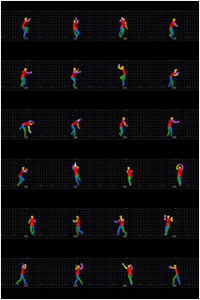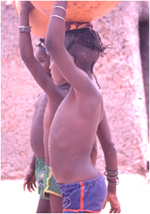- Home
- > Study Groups and their Achievements
- > Group 2: Overview of Arrangement and Systematization of Physical Techniques and Sensibility
Study Groups and Achievements
Arrangement and Systematization of Physical Techniques and Sensibility
Group 2: Overview of Arrangement and Systematization of Physical Techniques and Sensibility

Comparative study on techniques of body and senses – or how the human body is manipulated under cultural conditions – needs to be conducted from a broad view of human history. To clarify this notion, we examined techniques of body and senses observed in France, the United States, Mexico and Mongolia. In addition, as part of our research on the performing arts, we carried out field studies in Japan and China to make a quantitative comparison of folk and traditional performing arts in East Asia by use of a magnetic motion capture system which enables us to measure angle changes in the human form.

We also compared wooden mortars used in the Tohoku Region (the northeastern area of Japan’s main island) and the Chubu Region (the central area) to explore what can be discovered regarding the relationship between tools and human bodily movements by studying techniques of body and senses. Based on differences in the shape of wooden mortars, we can recreate working postures which indicate techniques of body and senses adopted by users. Consequently, a comparative study of folk implements allows us to reveal differences in techniques of body and senses throughout the country and ultimately to grasp ethnic distribution in earlier times. For this program, we aimed to discover that of the Kofun era from A.D. 250 to A.D. 385.
Tasks for Group 2
- Task 1: Comparative Study of Physical Techniques
- Task 2: Analysis of the Relationship between Tools and Human Movement
Researchers (as of March 31, 2008)
- Program Representatives
- HIROTA Ritsuko, YAMAGUCHI Kenji
- Joint Researchers
- XIA Yuji, KAWADA Junzo
- Research Collaborators
- OKAMOTO Koichi, KAIGA Takaaki
- Program Representative
- KAWANO Michiaki
